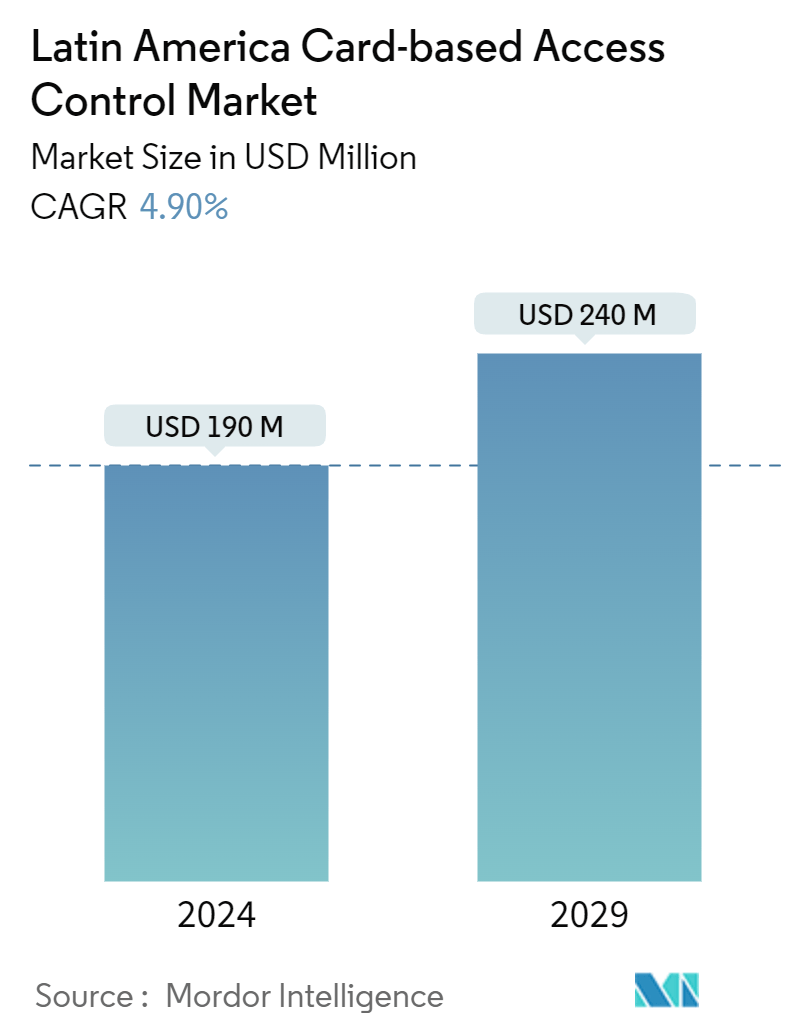Market Size of Latin America Card-based Access Control Industry

| Study Period | 2019 - 2029 |
| Base Year For Estimation | 2023 |
| Market Size (2024) | USD 190 Million |
| Market Size (2029) | USD 240 Million |
| CAGR (2024 - 2029) | 4.90 % |
| Market Concentration | Medium |
Major Players
*Disclaimer: Major Players sorted in no particular order |
Latin America Card-based Access Control Market Analysis
The Latin America Card-based Access Control Market size is estimated at USD 190 million in 2024, and is expected to reach USD 240 million by 2029, growing at a CAGR of 4.90% during the forecast period (2024-2029).
- In a card-based access system, multiple components work together. Among these, the access control card reader stands out as pivotal. It is responsible for scanning data from the key card or fob and deciding on access permissions. Card-based access control systems are now a cornerstone of contemporary security measures. They empower businesses to oversee and regulate facility access, offering this control remotely from any corner of the globe, ensuring security and operational efficiency.
- Increasing construction and infrastructure projects, alongside a surge in criminal activities, are driving the demand for card-based access control systems in Latin America. Governments are ramping up investments to combat rising crime rates, notably through the deployment of access control systems.
- For instance, in December 2023, the Federal Government introduced the "Routes for Integration" initiative. This project is expected to receive around USD 10 billion in funding from development banks to create a network of routes to promote South American integration and development. The main goal is to shorten distances, enhance logistics, simplify connections, and increase productivity. The infrastructure developments consist of infoways, hydroways, roadways, railways, ports, airports, and electricity transmission lines.
- Modern apartment buildings often feature a range of amenities, from pools and fitness centers to conference rooms and mailrooms. Securing these spaces is paramount. By installing readers at their entrances, buildings can restrict access to only approved tenants and staff. Controlled access buildings may also need security measures for areas like parking garages, elevators, server rooms, and equipment spaces.
- The lack of public awareness and operational concern of newly created wireless locks that can be operated with cards, as well as their expanded benefits when combined with the cloud, pose a barrier to the expansion of this market.
- The card-based access control market in Latin America is semi-consolidated, with less number of players occupying a moderate level of market share. Vendors operating in the market are focusing on new product development, strategic partnership, acquisition, and expansion to meet the growing demand from the customers, further supporting the market’s growth.
- Furthermore, smart city initiatives are gaining momentum in Latin America. The governments in the region are increasingly turning to technology for urban development, a move that is set to drive up the demand for card-based access control systems in the coming years.
- The availability and reliability of card-based access control systems are greatly influenced by macroeconomic factors like government regulations on import/export. These regulations differ across nations, often demanding thorough certifications, testing, and compliance with particular standards. Despite their goal of ensuring safety and quality, these regulations can present substantial obstacles for manufacturers, distributors, and consumers. Delays in card-based access control system availability due to import/export rules can impede their prompt deployment in different end-user sectors.
Latin America Card-based Access Control Industry Segmentation
Card access control systems, commonly referred to as key fob access control systems, are electronic door security systems. They employ card readers in conjunction with key fobs to regulate access to designated areas within a building or facility. The study tracks the revenue accrued through the sale of card-based access control products by various players in Latin America. It also covers the key market parameters, underlying growth influencers, and major vendors operating in the market, which supports the market estimations and growth rates over the forecast period. The study further analyses the overall impact of COVID-19 aftereffects and other macroeconomic factors on the market. The report's scope encompasses market sizing and forecasts for various market segments.
The Latin American card-based access control market is segmented by card type (swipe cards, RFID proximity cards, and smart card [contact and contactless], component (card readers, access control keypads, access control panel, and electronic lock hardware, and other components), end-user vertical (commercial, residential, government, industrial, transport and logistics, healthcare, military and defense, and other end-user verticals), and country (Brazil, Mexico, Argentina, and Rest of Latin America). The market sizes and forecasts are provided in terms of value in USD for all the above segments.
| By Card Type | |
| Swipe Cards | |
| RFID Proximity Cards | |
| Smart Card (Contact and Contactless) |
| By Component | |
| Card Readers | |
| Access Control Keypads | |
| Access Control Panels | |
| Electronic Lock Hardware | |
| Other Components |
| By End-user Vertical | |
| Commercial | |
| Residential | |
| Government | |
| Industrial | |
| Transport and Logistics | |
| Healthcare | |
| Military and Defense | |
| Other End-user Verticals |
| By Country*** | |
| Brazil | |
| Mexico | |
| Argentina |
Latin America Card-based Access Control Market Size Summary
The Latin America card-based access control market is experiencing a steady expansion, driven by the increasing need for enhanced security measures across various sectors. These systems, which include key card and fob readers, are integral to modern security infrastructures, allowing businesses to manage access remotely and efficiently. The demand for such systems is being propelled by a rise in construction and infrastructure projects, as well as a surge in criminal activities, prompting governments to invest heavily in security solutions. Initiatives like the "Routes for Integration" project highlight the region's commitment to improving logistics and connectivity, further boosting the need for robust access control systems. Despite challenges such as limited public awareness and regulatory hurdles, the market is witnessing growth due to strategic partnerships and technological advancements, including the adoption of smart cards and cloud-based solutions.
The market landscape in Latin America is semi-consolidated, with key players like ADT LLC, Allegion PLC, ASSA ABLOY AB, HID Global Corporation, and Axis Communications AB actively competing through product innovations and strategic acquisitions. The integration of smart cards is particularly notable, as they offer enhanced security features and are gradually replacing older proximity card technologies. The increasing adoption of smart cards is driven by their cost-effectiveness and ease of use, making them a preferred choice for businesses seeking comprehensive security solutions. As smart city initiatives gain traction, the demand for card-based access control systems is expected to rise, supported by advancements in authentication technologies like RFIDs. The market's growth is further bolstered by the expanding construction activities in countries like Brazil, where the need for secure access control systems is becoming increasingly critical.
Latin America Card-based Access Control Market Size - Table of Contents
-
1. MARKET INSIGHTS
-
1.1 Market Overview
-
1.2 Industry Attractiveness - Porter's Five Forces Analysis
-
1.2.1 Threat of New Entrants
-
1.2.2 Bargaining Power of Buyers/Consumers
-
1.2.3 Bargaining Power of Suppliers
-
1.2.4 Threat of Substitute Products
-
1.2.5 Intensity of Competitive Rivalry
-
-
1.3 Industry Value Chain Analysis
-
1.4 Impact of COVID-19 Aftereffects and Other Macroeconomic Trends on the Market
-
-
2. MARKET SEGMENTATION
-
2.1 By Card Type
-
2.1.1 Swipe Cards
-
2.1.2 RFID Proximity Cards
-
2.1.3 Smart Card (Contact and Contactless)
-
-
2.2 By Component
-
2.2.1 Card Readers
-
2.2.2 Access Control Keypads
-
2.2.3 Access Control Panels
-
2.2.4 Electronic Lock Hardware
-
2.2.5 Other Components
-
-
2.3 By End-user Vertical
-
2.3.1 Commercial
-
2.3.2 Residential
-
2.3.3 Government
-
2.3.4 Industrial
-
2.3.5 Transport and Logistics
-
2.3.6 Healthcare
-
2.3.7 Military and Defense
-
2.3.8 Other End-user Verticals
-
-
2.4 By Country***
-
2.4.1 Brazil
-
2.4.2 Mexico
-
2.4.3 Argentina
-
-
Latin America Card-based Access Control Market Size FAQs
How big is the Latin America Card-based Access Control Market?
The Latin America Card-based Access Control Market size is expected to reach USD 190 million in 2024 and grow at a CAGR of 4.90% to reach USD 240 million by 2029.
What is the current Latin America Card-based Access Control Market size?
In 2024, the Latin America Card-based Access Control Market size is expected to reach USD 190 million.

